"Bambi" Match Racing Call B11
For Match Racing and Team Racing there are many instances where rules scenarios that are uncommon in fleet racing occur. Rather than clog up the rule book to cope with all of these situations, a Call Book is published for each format.
Last weekend at Newcastle, an Umpire’s green flag was questioned on a port-starboard. That scenario was almost identical to the situation in this Match Racing call B11 – nicknamed “Bambi” – The deer in the headlights that can’t do anything else.
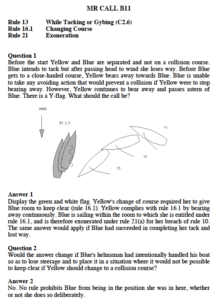
New Cases - World Sailing
World Sailing have published 3 new cases that are worthwhile reading – Here is a summary of each case.
Case 144
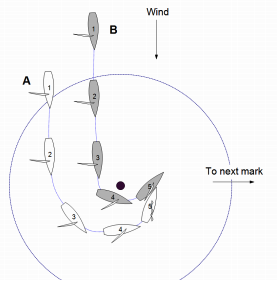
An obligation to give mark-room continues until the entitled boat has passed the mark, leaving it on the required side.
The definition Mark-Room defines the space a boat is required to give, and the other boat is exonerated under rule 21 only if she is sailing within that space.
Case 145
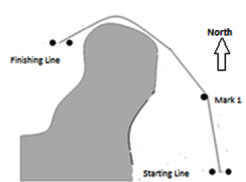
A boat’s string, referred to in rule 28.2, when drawn taut, is to lie in navigable water only.
Case 146
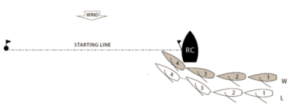
When boats are approaching a starting mark to start and a leeward boat luffs, the windward boat is exonerated under rule 21(a) if she breaks rule 11 while sailing within the room to which she is entitled under rule 16.1.
More Q&As from World Sailing
These Q&As have been published by World Sailing
2019.014.J009 is probably the only one of much interest to sailors who want to request a hearing be reopened.
| World Sailing Q&A 2019.015 N008 | Special Events and rule 89.1 |
| World Sailing Q&A 2019.014 J009 | A question or rules governing hearing reopenings |
| World Sailing Q&A 2019.013 J008 | Decisions under rule 71 |
| World Sailing Q&A 2019.011 N006 | Affiliation for radio sailing organisations |
| World Sailing Q&A 2019.010 N005 | World Sailing Classes as the organising authority of an event |
What do the Signals (flags) mean
All of the Flag signals we use are defined in the section of the Racing Rules of Sailing called “Race Signals”.
Here is a handy A4 version of Race Signals
You’ll see that a lot of these signals refer to rules, so you need to understand the rule to understand the signals – Here is a handy rules guide that has 99% of the rules and definitions regarding the Conduct of a Race.
World Sailing Q&As
World Sailing have published some Q&As that Answer Questions about the Racing Rules and Procedures used.
Missing mark and a moving replacement.
Rule 18.3 at a windward finishing mark
Protest Hearings
An experienced Jury chairman will run the hearing according to a standard procedure.
Here is an outline of what to expect.
- The hearing should start on time and parties (usually you and the other boat) need to be there
- Your witnesses need to be available to be called
The Chair will run, control and direct proceedings as follows.
- Introductions
- Conflict of interest
- Protest validity
- Protestor explains incident
- Protestee explains incident
- They may each question each other about the explanation
- (Leading questions not allowed)
- The jury may ask questions at any time, but usually leave specific questions until the end of evidence being heard
- Protestor witness explains what they saw
- Protestor witness asked questions
- Protestee witness explains what they saw
- Protestee witness asked questions
- Final questions
- Protestor sums up their view of the incident
- Protestee sums up their view of the incident
- Jury Deliberates and decides protest
- Parties recalled and the decision announced
- Hearing closed
That is the basic running order, here are a couple of further details.
- Let the Chair run the hearing, everyone gets a chance
- Once a protest is determined to be valid – notification red flags , valid form etc… – validity is not addressed again in the hearing
- Leading questions will be disallowed
- Model boats are available and are very useful to illustrate an explanation
- The chair will manage the procedures and the order that questions are asked – follow their lead
- Evidence is weighted on a number of factors.
- The jury will focus on determining key facts and aspects that are in dispute
- Some details are of little importance to the decision – only say what is relevant
- All evidence is heard in the presence of the parties, but witnesses do not get to hear other evidence
- Observers may be allowed, but they must not communicate with anyone at all or they will be removed from the hearing
- The Jury will deliberate in private and may pause mid-hearing to do so
- It is a boat’s responsibility to organise witnesses, the jury may call further witnesses if it wants to
- Video is rarely useful or conclusive, but may support establishing a specific fact or aspect
Evidence
- The Jury weights evidence
- Use plain english, avoid jargon
- Accurate recall of specific details can vary
- If unsure of an aspect or the answer to a question – say so, don’t guess or give a convenient answer
- The Jury uses the best evidence from the whole hearing to determine facts
- 1 good witness is usually better than 3 poor witnesses
- Perfectly identical evidence raises a concern that it is scripted and rehearsed
- It is rarely useful to call additional witnesses that do not add anything or anything new to your case
- If someone has a different recollection, it does not mean they are lying or that you are lying
Before the hearing, try to understand the rules that applied:
- If you work out you broke the rule – why not take a scoring penalty or retire?
- Multiple rules can apply and transition during an incident
- Understand each of the definitions that apply to the rules used
- Understand which boat had right of way and what limitations apply to he right of way boat.
- See below for an example
- Don’t use old rules or words from old words “Mast abeam” , “Tacking in my water”
Manners
- Use good manners at all times
- Don’t attack the person
- Refrain from assigning intent, many mistakes are misjudgements or not understanding the rule
- Respect the volunteer officials they are applying a process that World Sailing prescribes – you agreed to those rules and procedures when you entered the race
The decision.
- The decision will be decided on the balance of probabilities after the Jury weighs the evidence
- Often the evidence is not conclusive, but the jury has to decide on the balance of probabilities
- The Jury decides facts, these cannot be appealed
- Consider the decision, are the conclusions supported by the facts that were determined based on the weighted evidence and the balance or probabilities
- Start thinking about sailing well in your next race
Startline Parallax

Startlines can be tricky to judge for sailors and in the very carefully worded World Sailing Case 136 it is acknowledged that a correctly positioned Race Committee member following the correct procedures will usually provide more reliable evidence than a boat on the start line.
The diagram above and this facebook clip (from Volunteer at the NEXT GEN start illustrate how the Start boat is positioned better than some racing boats to determine if a boat is OCS.
The start boat can see the green boat is below the line, but the yellow boat is likely to think it is over.
This is also referred to as the Parallax effect that you can review here https://en.wikipedia.org/wiki/Parallax
Penalty to right of way boat
At the Sorrento Cup, one incident that was closely observed by the umpires nearly had a penalty against the boat that was on starboard, then had mark room and then was leeward right of way.
- Approaching the top mark B was on Port and Y on Starboard. (RRS 10 B Keep Clear)
- X cleared in front of Y and then changed tack in the zone (RRS 13 B Keep Clear)
- After B came to her close-hauled course and was clear ahead (RRS 12 B is Right of way; But RRS 15 B needs to Initially give room for Y to Keep Clear)
- B gave room for Y to pass between her and the mark (RRS 18.3)
- Y came from astern and became overlapped to leeward of B and initially gave B room to keep clear (RRS 15 Limitation for Y, but exonerated under RRS 21 if only taking the mark room she requires, RRS 17 limitation on proper course for Y, RRS 11 B needs to keep clear and give mark room under RRS 18.2)
- After passing the mark B luffs, above her proper course to the hitch, and B promptly luffs to keep clear. (RRS 17 Y breaks the rule and RRS 11 Y keeps clear)
- Y is quite vocal in hailing “Up” when she is not allowed to sail above her proper course (Sailing Instruction 1.7 It is unsportsmanlike to intimidate another boat when the other boat is keeping clear and the hailing boat is breaking a rule – Umpire considers an umpire-initiated penalty)
- Y bears down to her proper course – no more hailing and no clear actions of protest by either boat (incident closed)
A couple of observations
- If either boat had hailed protest, Y would have been penalised.
- If hailing “Up” had continued or if Y had argued or told off B, Y would have earned an umpire-initiated penalty.
- B did all the right things. If she had not luffed and kept clear when Y luffed above her proper course, B would have been penalised as well as Y.
URGENT RULE CHANGE
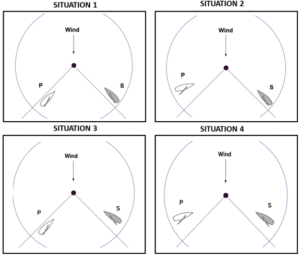
World Sailing have published this change to case 132 effective 3 December 2018.
Protests and Validity
We had a bit of discussion following an Arbitration, protest and de-brief and it seems that it would be worthwhile sharing with the whole fleet.
First up the, the representatives conducted themselves with good grace and sportsmanship and were careful to ensure they did not let any emotions come into play in the hearing: That’s great!
The arbitration did not end up with either boat taking a penalty, so the matter proceeded to a protest, with a protest committee of three people.
Informing the protested boat, validity and Protest Committee Actions
The protest was found to be invalid, due to the timing display of the red flag. The parts of the rules that were applied are in bold below:
——————————–
61.1 Informing the Protestee
- A boat intending to protest shall inform the other boat at the first reasonable opportunity. When her protest will concern an incident in the racing area that she was involved in or saw, she shall hail ‘Protest’ and conspicuously display a red flag at the first reasonable opportunity for each. She shall display the flag until she is no longer racing.
63.5 Validity of the Protest or Request for Redress
At the beginning of the hearing the protest committee shall take any evidence it considers necessary to decide whether all requirements for the protest or request for redress have been met. If they have been met, the protest or request is valid and the hearing shall be continued. If not, the committee shall declare the protest or request invalid and close the hearing. If the protest has been made under rule 60.3(a)(1), the committee shall also determine whether or not injury or serious damage resulted from the incident in question. If not, the hearing shall be closed.
60.3 A protest committee may
- protest a boat, but not as a result of information arising from a request for redress or an invalid protest, or from a report from a person with a conflict of interest other than the representative of the boat herself. However, it may protest a boat
- if it learns of an incident involving her that may have resulted in injury or serious damage, or
- if during the hearing of a valid protest it learns that the boat, although not a party to the hearing, was involved in the incident and may have broken a rule;
- call a hearing to consider redress;
- act under rule 2(b); or
- call a hearing to consider whether a support person has broken a rule, based on its own observation or information received from any source, including evidence taken during a hearing.
——————————-
In these situations, the protest committee has no choice under the rules but to close the hearing when the requirements have not been met, it’s not a choice that they have and no further details of the incident, or whether it has merit can be considered unless there is serious damage or injury.
New Team Racing Rapid Response
World Sailing have published this Rapid Response for Team Racing.
http://sailing.org/tools/documents/RRTRC2018.001-[24500].pdf
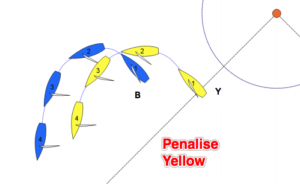
Note: This is at the windward mark. A Boat does not have a proper course before her starting signal.
Sailing a rival off the course
The Couta Boat aggregate comes to a climax this weekend with 2 races scheduled, with only a few points separating the leaders, there could be some match racing.
Let’s explore what boats can and can’t do.
Rule 24 Interfering with another boat.
24.2 states that if reasonably possible, a boat shall not interfere with a boat on another leg, but the rule does not apply when sailing her proper course, Case 126 explores some of the situations when this rule could be applied
Case 78 This is the permissive rule – It states when a boat can fairly hinder another boat’s progress – But there are strict limits on what’s fair play.
If a boat sticks within these limitations, it’s a fair duel.
Then we have a few cases that explicitly state what’s not fair play and even allows for redress for the infringed boat. In summary, don’t break a rule when you interfere with another boat.
Case 34 – Hindering another boat may be a breach of rule 2 and the basis for granting redress and for action under rule 69.2.
Case 65 – A boat knows she should take a penalty – but continues to interfere with another boat
TR - New calls - Mark Room is not unlimited
The Call Book supplement has been updated with the most significant changes limiting a boat with mark-room, to only use that mark-room: She doesn’t “own the zone”.
In Call E5 below, yellow gets penalised
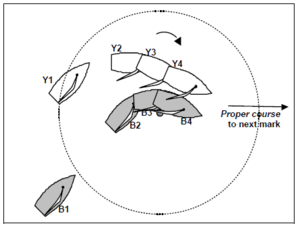
In Call H2, the blue boats get penalised because she had mark room and was right of way but did not give Y room to keep clear.
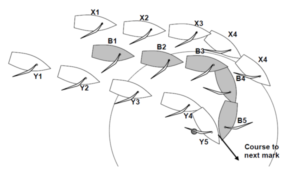
In Call H5 yellow with mark room is exonerated when she resumes her proper course at Position 3 – even though she is give way boat.
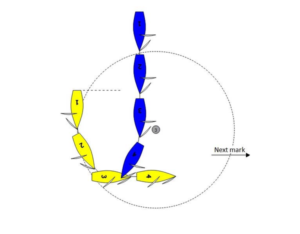
This will see some changes in the way the game is played – Many racers and umpires have had an inaccurate view of mark-room, often the game is played such that a boat that gets mark room and doesn’t leave the zone completely owns it – that will change.
- "Bambi" Match Racing Call B11
- New Cases - World Sailing
- More Q&As from World Sailing
- What do the Signals (flags) mean
- World Sailing Q&As
- Protest Hearings
- Startline Parallax
- Penalty to right of way boat
- URGENT RULE CHANGE
- Protests and Validity
- New Team Racing Rapid Response
- Online Rules Seminar
- Sailing a rival off the course
- TR - New calls - Mark Room is not unlimited















